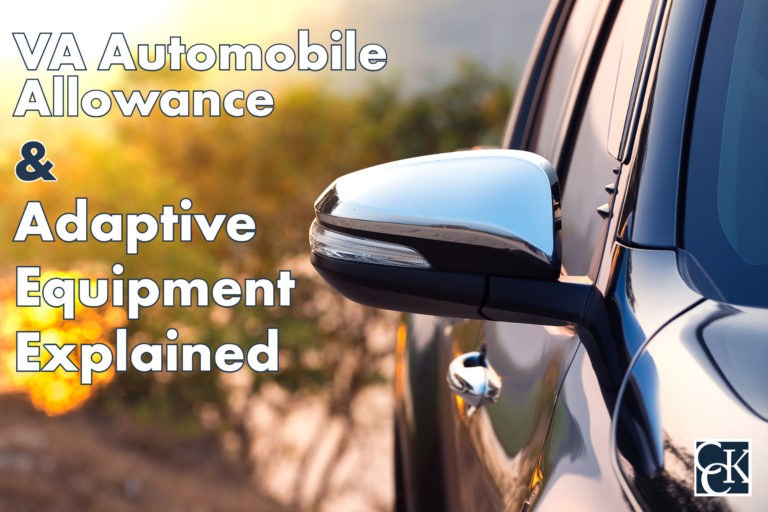VA Automobile Allowance and Adaptive Equipment Explained

CCK Law: Our Vital Role in Veterans Law
While veterans are often aware of or participate in the VA health care system and receive VA disability compensation for their service-connected disability, many veterans are unaware of the more obscure benefits, such as the automobile adaptive allowance.
What is the VA Automobile Allowance?
Automobile adaptive allowance is a benefit offered by VA to veterans who have a service-connected disability that prevents them from being able to drive. In addition to the allowance, VA offers an adaptive equipment benefit to assist veterans with certain types of impairments.
If awarded the automotive allowance, the benefit consists of a one-time payment of $21,488.29 that may be used to help buy a specially equipped vehicle as of 2021. In terms of adaptive equipment, the benefit may be used to alter a vehicle.
Examples of Adaptive Equipment
- Power steering
- Brakes
- Seats
- Windows
- Lift equipment to enter and exit the vehicle
Who is Eligible for Automobile Allowance or Adaptive Equipment?
The automotive allowance and adaptive equipment benefit is available to veterans and service members who have a service-connected disability that VA recognizes as impacting their ability to drive. The veteran or service member must have at least one of the service-connected conditions on VA’s approved list.
What Conditions Are Approved for Automobile Allowance?
In order to qualify for automotive allowance or adaptive equipment, the veteran or service member will need to have one of the following conditions:
- Loss, or permanent loss of use, of 1 or both feet, or
- Loss, or permanent loss of use, of 1 or both hands, or
- Permanent decreased vision in both eyes: 20/200 vision or less in your better eye with glasses, or greater than 20/200 vision but with a visual field defect that has reduced your peripheral vision to 20 degrees or less in your better eye, or
- A severe burn injury, or
- Amyotrophic lateral sclerosis (ALS), or
- Ankylosis in 1 or both knees or hips (Note: This condition only qualifies for an adaptive equipment grant).

How to Apply for an Automotive Allowance and Adaptive Equipment Grant: VA Form 21-4502
To apply for an automotive allowance or an adaptive equipment grant, the veteran or service member must have been awarded service connection before buying the vehicle or installing adaptive equipment. Servicemembers may apply for these grants before military discharge, or after.
When filing for a grant for either an automotive allowance or an adaptive equipment allowance, veterans will need to indicate that they are service-connected for one of the approved conditions.
To apply for automobile allowance for a specially equipped vehicle, service members or veterans will need to fill out VA Form 21-4502, or Application for Automobile or Other Conveyance and Adaptive Equipment. If the grant is awarded, VA will pay the vehicle’s seller directly.
To apply for the adaptive equipment grant, servicemembers will need to fill out VA Form 10-1394, or Application for Adaptive Equipment-Motor Vehicle. For this grant, VA will either pay the veteran or service member or may pay the equipment seller directly.
Timeline of Automobile Allowance Benefits
Generally, the process for being awarded an automotive allowance will follow this path:
- Application for Benefit—Veteran or servicemember applies for the automotive allowance by filling out VA Form 21-4502 and submitting it to their Regional Office (RO).
- Decision Issued—The RO makes a decision either granting or denying the allowance. To make this decision, the RO will need to evaluate whether the veteran has an eligible condition and if the person has received the allowance previously. The allowance can only be issued once so if a person previously received it, they will be denied.
- Section II—If the RO has determined that the veteran is eligible for the automotive allowance, the RO will fill out Section II of the VA Form 21-4502 that the veteran or service member submitted. The RO will then mail this to the veteran or servicemember.
- Section III—Upon receiving the form with completed Section II, the veteran or servicemember may then acquire the vehicle. They will complete Section III of the form and then mail it back to the RO.
- Invoice—The seller of the vehicle then will send the invoice for the vehicle to the RO.
- Completion of Payment—Finally, upon receipt of the invoice, the RO finance department will complete the payment of the automotive allowance to the seller.
Timeline of Adaptive Equipment Allowance
The timeline and process for the adaptive equipment grant is very similar to the process for the automatic allowance, but with a few key differences.
- Application for Benefit—The veteran or service member will need to fill out VA Form 10-1394. The form may be supplied by a VA outpatient clinic, whose prosthetics department can forward the form to the local VA RO.
- Decision Issued—The RO will make a decision once the form has been received. To make this determination, the RO will consider if the veteran has a qualifying, service-connected disability, the effective date of the service-connected disability, and if special authorization by the local VA outpatient clinic has been granted. If the RO makes the determination that the veteran is not eligible for the adaptive equipment grant, the RO will return the form to the VA outpatient clinic. If the RO approves the grant, the prosthetic department of the treating VA Medical Center or clinic should complete the form and send it back to the RO finance department for payment.
- Payment—Payment will be completed once it is sent to either the veteran or the installer of the adaptive equipment.
Note: While the automotive allowance can only be issued once, a grant for adaptive equipment can be issued multiple times, especially if the equipment needs to be repaired or replaced.
Was Your Claim for VA Benefits Denied?
If your claim for benefits was denied, it does not mean your case is unwinnable. The experienced team at Chisholm Chisholm & Kilpatrick can help you with your appeal. For a free case review, call our office today at 800-544-9144.
About the Author
Share this Post
